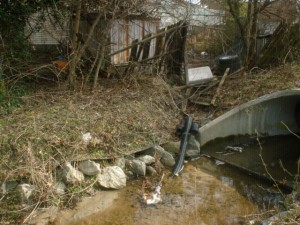“Rain, rain, go away, come back another day” is a familiar nursery rhyme we all know. Our stormwater infrastructures help make rain “go away”.
But do we really understand how our city stormwater management system works? Engineers have designed a system for removing excess RAIN WATER! It is called “stormwater infrastructure”
The system does NOT TREAT the rain water; instead, it directs the rain water to a nearby creek, river or the Chesapeake Bay. It does not take out oil, paint, soaps, fertilizers, grass clippings, leaves, yard debris, and litter including cigarette butts and tips. Those items POLLUTE and PLUG UP our drainage system, causing harm to our property, wildlife, marine life, and environment.
FLOODING occurs when:
- The rainfall is greater than what the stormwater infrastructure was designed for.
- Storm Surge (the abnormal rise of the sea caused by a storm’s atmospheric pressure & wind) flows up into our stormwater drainage system and onto the streets and land. (Nor’easters, hurricanes etc.) Storm Tide is the combination of Storm Surge & astronomical tide.
- The stormwater system is blocked by debris, grass clippings, leaves, yard waste inside drainage pipes or at the entrance of the stormwater drainage system.
- Soil sediment reduces the flow of water at entrance or inside drainage culverts.
Who is responsible?
Everyone!
- Citizens are responsible to make sure that debris, grass clippings, leaves, and yard waste do not enter the street or drainage system on their property including the easement. Also, they are to make sure on trash pickup day, the debris is not blocking the drainage system.
- The municipality is responsible for keeping a routine maintenance cleanout schedule so rainwater flows properly, along with replacing broken or upgrading inadequate stormwater infrastructure of city owned structures.
Stormwater infrastructure looks a little different than your average street, bridge or communications tower. But it’s still up to us to work together to keep it flowing! Check out these common stormwater practices:



